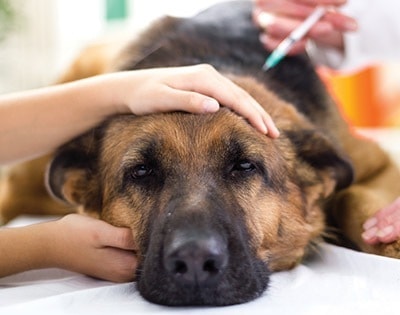
What is Canine Influenza?
Also known as: Canine Flu, Dog Flu
Canine influenza is a highly contagious respiratory infection caused by the H3N8 or H3N2 viruses and is easily spread between dogs. These influenza viruses are a serious and significant illness in dog boarding and daycare facilities, grooming salons, animal shelters, and other animal care facilities.
Aerapy Animal Health’s UV technology was tested against canine influenza (H3N8) and achieved a >99.994% kill rate.
Visit our Research & Studies page to learn more.
What causes canine influenza?
Canine flu is caused by the spread of two different virus strains: H3N8 and H3N2. It is a relatively new disease in the U.S. that began affecting dogs in 2004. The first case was diagnosed in greyhounds at a racing track in Florida. This H3N8 strain of the virus is believed to be similar to the influenza virus affecting horses (scientists have confirmed the virus mutated to cross species from horses to infect dogs). Within three months of its discovery, cases of H3N8 canine flu and its associated symptoms began sprouting up in various regions. Since then, the H3N8 strain has been reported throughout most of the U.S.
In 2015, the H3N2 strain of the virus was found in several dogs exhibiting canine influenza symptoms. This strain showed similarities to the avian (bird) flu from Asia and spread even more quickly than the H3N8, with 23 states confirming infections within five months of its first diagnosis in the U.S. As was the case in 2004, it is thought that the virus was able to mutate and cross species, this time from birds to dogs. Thousands of dogs across the U.S. have been infected with the H3N2 strain of the dog flu in the years since it emerged. In 2018, a cluster of dogs in Canada were confirmed infected with the H3N2 virus strain.
How is canine influenza transmitted?
Canine influenza is a highly contagious airborne and aerosolized disease that can spread quickly in settings with multiple dogs. The virus can travel long distances and remain viable for extended periods of time, even weeks in some instances, traveling on microscopic pieces of dust and debris. These microbes are known as droplet nuclei. Once they are inhaled by an unsuspecting host they can result in clinical infections. For example, when an infected dog coughs, sneezes, sheds, barks, or pants, the virus is carried through the air waiting to be inhaled into the lungs of another host. The virus can also land on a surface where it can then be carried on hands, supplies, or clothing to a new host. If a dog drinks out of a bowl, licks a spoon, or sniffs a toy that has been in contact with an in infected dog, he can contract the dog flu. The virus can survive on surfaces for up to 48 hours, on clothing for 24 hours, and on hands for 12 hours.
This is why it is essential that dog daycares and pet boarding facilities, veterinarians, groomers, animal shelters, and anyone working with pets keep their person and facility clean and sanitary. Hands should be washed in between handling animals. Sick animals should be isolated while air and all surfaces are thoroughly disinfected and sanitized.
Why surface versus air disease transmission distinction is extremely important to understand.
Surface cleaning alone will not eliminate the aerosolized droplet nuclei that may still be in the air and still infectious for extended periods of time, just waiting to be inhaled by another animal. For effective prevention and elimination of influenza viruses, the air must also be sanitized. For more information on the aerosolized transmission of dog flu, the Centers for Disease Control and Prevention (CDC) have published a “Review of Aerosol Transmission of Influenza A Virus” on the CDC website.
What are the symptoms of canine influenza?
If a dog is exposed to a canine flu environment and contracts the disease, he will begin showing symptoms of the disease within 2-4 days. Many dogs contract a mild form of the virus, whereas other dogs develop a secondary infection and suffer from a more severe form of it. Typically, only 10-20% of dogs infected with the canine influenza virus will contract the more severe form.
Both strains cause the same signs and symptoms of the dog flu:
How can canine influenza be prevented?
For pet owners, having a dog suffer from canine flu can be quite taxing—as much on the heart as the wallet. For pet care businesses, the heavy burden far exceeds concerns about costs. Businesses that experience an outbreak often shut down for a brief amount of time to prevent further transmission. While the business itself isn’t completely to blame for an outbreak such as this, the effects will surely be felt for a long time. This is why prevention is the best option.
Boarding Facilities, Veterinary Clinics, and Animal Shelters
Sanitize the air. Every kennel, pet boarding facility, dog daycare, shelter, rescue, veterinary clinic, mobile unit, grooming salon, pet shop with live animal sales, breeder, or other animal care facility should have a proper UV air purification system in place to eliminate airborne bacteria and viruses. UV historically has been used in human healthcare settings to prevent the spread of infectious airborne diseases. As discussed previously, canine influenza is spread by airborne transmission; the infectious pathogens can survive on dust particles and dander for extended periods of time. Effective air cleaning systems that will kill infectious pathogens, while being safe for humans and animals, must be designed and properly sized for animal care facilities and specifically tested to help eliminate animal pathogens.
Ensure the facility has adequate airflow and ventilation as part of your air cleaning protocol. Air filters should be appropriate for the facility and changed on a regular schedule.
Rigorous disinfection routine. Everything must be thoroughly disinfected regularly. Bowls and dishes, kennels, tables, toys, all equipment, etc., should be sterilized regularly. Associates must be trained on how to clean and on protection protocols for the prevention of disease spread. Even the order in which one cleans can impact the spread of disease.
Have vaccination protocols that meet the needs of your business and your surrounding geographic area. Consult with your local veterinarian for vaccine information. Ensure pets are vaccinated before intake and educate owners on why this is important.
Train staff on the importance of monitoring pets for infectious disease and isolating pets at the first sign of illness to help prevent further exposure. Ensure pets receive proper medical attention immediately.
Pet Owners
Choose a doggie daycare, dog boarding, pet resort, or kennel facility carefully. Always make sure that the facility is doing all they can to prevent outbreaks of canine influenza and other pet-related illnesses. Always ask for a tour of the facility and ask about their sanitation protocols, including what they do to clean the air.
Keep your dog up to date on his vaccines. Pet owners can breathe a little easier now that vaccines are in place for both the H3N2 and H3N8 strains of the canine flu, but many kennels, daycare and boarding facilities require only a kennel (canine) cough vaccine. If you are boarding your dog, speak to your vet about vaccinations for the dog flu as well. Your dog will need to be vaccinated against both strains, as the vaccine for one is not effective for the other. Be aware that the H3N8 vaccine requires two shots two weeks apart and you should plan accordingly to have your dog properly vaccinated.
Keep pets that have symptoms isolated from other pets. It is very challenging to isolate sick pets once they begin feeling better but until they have been completely cleared it is important to not have them around other pets.
For more information and details for both pet care facilities and pet parents on how best to prevent the spread of infectious disease, visit our kennel cough page.
How is canine influenza treated?
The following is not intended as a substitute for professional medical advice, diagnosis, or treatment for your pet. Consult your veterinarian for questions and information regarding your pet’s health.
Thankfully, the mortality rate for this disease is low, reaching between 5–8%. Most dogs recover fully within 2–3 weeks of showing symptoms. Nevertheless, proper treatment of canine influenza is important. All pets showing signs of influenza should be evaluated by a veterinarian.
Because canine influenza is a virus, antibiotics are not typically used unless there are secondary bacterial infections. It is up to the dog’s body to do the work and recover. As a result, much of the treatment for canine flu consists of supportive care designed to strengthen the dog’s immune system and help him recover faster. Ensuring your pet gets evaluated by a veterinarian, along with adequate rest, fluids, and nutrition, are important parts of recovery.
CANINE INFLUENZA QUICK LINKS
What causes canine influenza?
Canine flu is caused by the spread of two different virus strains: H3N8 and H3N2. It is a relatively new disease in the U.S. that began affecting dogs in 2004. The first case was diagnosed in greyhounds at a racing track in Florida. This H3N8 strain of the virus is believed to be similar to the influenza virus affecting horses (scientists have confirmed the virus mutated to cross species from horses to infect dogs). Within three months of its discovery, cases of H3N8 canine flu and its associated symptoms began sprouting up in various regions. Since then, the H3N8 strain has been reported throughout most of the U.S.
In 2015, the H3N2 strain of the virus was found in several dogs exhibiting canine influenza symptoms. This strain showed similarities to the avian (bird) flu from Asia and spread even more quickly than the H3N8, with 23 states confirming infections within five months of its first diagnosis in the U.S. As was the case in 2004, it is thought that the virus was able to mutate and cross species, this time from birds to dogs. Thousands of dogs across the U.S. have been infected with the H3N2 strain of the dog flu in the years since it emerged. In 2018, a cluster of dogs in Canada were confirmed infected with the H3N2 virus strain.
How is canine influenza transmitted?
Canine influenza is a highly contagious airborne and aerosolized disease that can spread quickly in settings with multiple dogs. The virus can travel long distances and remain viable for extended periods of time, even weeks in some instances, traveling on microscopic pieces of dust and debris. These microbes are known as droplet nuclei. Once they are inhaled by an unsuspecting host they can result in clinical infections. For example, when an infected dog coughs, sneezes, sheds, barks, or pants, the virus is carried through the air waiting to be inhaled into the lungs of another host. The virus can also land on a surface where it can then be carried on hands, supplies, or clothing to a new host. If a dog drinks out of a bowl, licks a spoon, or sniffs a toy that has been in contact with an in infected dog, he can contract the dog flu. The virus can survive on surfaces for up to 48 hours, on clothing for 24 hours, and on hands for 12 hours.
This is why it is essential that dog daycares and pet boarding facilities, veterinarians, groomers, animal shelters, and anyone working with pets keep their person and facility clean and sanitary. Hands should be washed in between handling animals. Sick animals should be isolated while air and all surfaces are thoroughly disinfected and sanitized.
Why surface versus air disease transmission distinction is extremely important to understand.
Surface cleaning alone will not eliminate the aerosolized droplet nuclei that may still be in the air and still infectious for extended periods of time, just waiting to be inhaled by another animal. For effective prevention and elimination of influenza viruses, the air must also be sanitized. For more information on the aerosolized transmission of dog flu, the Centers for Disease Control and Prevention (CDC) have published a “Review of Aerosol Transmission of Influenza A Virus” on the CDC website.
What are the symptoms of canine influenza?
If a dog is exposed to a canine flu environment and contracts the disease, he will begin showing symptoms of the disease within 2-4 days. Many dogs contract a mild form of the virus, whereas other dogs develop a secondary infection and suffer from a more severe form of it. Typically, only 10-20% of dogs infected with the canine influenza virus will contract the more severe form.
Both strains cause the same signs and symptoms of the dog flu:
How can canine influenza be prevented?
For pet owners, having a dog suffer from canine flu can be quite taxing—as much on the heart as the wallet. For pet care businesses, the heavy burden far exceeds concerns about costs. Businesses that experience an outbreak often shut down for a brief amount of time to prevent further transmission. While the business itself isn’t completely to blame for an outbreak such as this, the effects will surely be felt for a long time. This is why prevention is the best option.
Boarding Facilities, Veterinary Clinics, and Animal Shelters
Sanitize the air. Every kennel, pet boarding facility, dog daycare, shelter, rescue, veterinary clinic, mobile unit, grooming salon, pet shop with live animal sales, breeder, or other animal care facility should have a proper UV air purification system in place to eliminate airborne bacteria and viruses. UV historically has been used in human healthcare settings to prevent the spread of infectious airborne diseases. As discussed previously, canine influenza is spread by airborne transmission; the infectious pathogens can survive on dust particles and dander for extended periods of time. Effective air cleaning systems that will kill infectious pathogens, while being safe for humans and animals, must be designed and properly sized for animal care facilities and specifically tested to help eliminate animal pathogens.
Ensure the facility has adequate airflow and ventilation as part of your air cleaning protocol. Air filters should be appropriate for the facility and changed on a regular schedule.
Rigorous disinfection routine. Everything must be thoroughly disinfected regularly. Bowls and dishes, kennels, tables, toys, all equipment, etc., should be sterilized regularly. Associates must be trained on how to clean and on protection protocols for the prevention of disease spread. Even the order in which one cleans can impact the spread of disease.
Have vaccination protocols that meet the needs of your business and your surrounding geographic area. Consult with your local veterinarian for vaccine information. Ensure pets are vaccinated before intake and educate owners on why this is important.
Train staff on the importance of monitoring pets for infectious disease and isolating pets at the first sign of illness to help prevent further exposure. Ensure pets receive proper medical attention immediately.
Pet Owners
Choose a doggie daycare, dog boarding, pet resort, or kennel facility carefully. Always make sure that the facility is doing all they can to prevent outbreaks of canine influenza and other pet-related illnesses. Always ask for a tour of the facility and ask about their sanitation protocols, including what they do to clean the air.
Keep your dog up to date on his vaccines. Pet owners can breathe a little easier now that vaccines are in place for both the H3N2 and H3N8 strains of the canine flu, but many kennels, daycare and boarding facilities require only a kennel (canine) cough vaccine. If you are boarding your dog, speak to your vet about vaccinations for the dog flu as well. Your dog will need to be vaccinated against both strains, as the vaccine for one is not effective for the other. Be aware that the H3N8 vaccine requires two shots two weeks apart and you should plan accordingly to have your dog properly vaccinated.
Keep pets that have symptoms isolated from other pets. It is very challenging to isolate sick pets once they begin feeling better but until they have been completely cleared it is important to not have them around other pets.
For more information and details for both pet care facilities and pet parents on how best to prevent the spread of infectious disease, visit our kennel cough page.
How is canine influenza treated?
The following is not intended as a substitute for professional medical advice, diagnosis, or treatment for your pet. Consult your veterinarian for questions and information regarding your pet’s health.
Thankfully, the mortality rate for this disease is low, reaching between 5–8%. Most dogs recover fully within 2–3 weeks of showing symptoms. Nevertheless, proper treatment of canine influenza is important. All pets showing signs of influenza should be evaluated by a veterinarian.
Because canine influenza is a virus, antibiotics are not typically used unless there are secondary bacterial infections. It is up to the dog’s body to do the work and recover. As a result, much of the treatment for canine flu consists of supportive care designed to strengthen the dog’s immune system and help him recover faster. Ensuring your pet gets evaluated by a veterinarian, along with adequate rest, fluids, and nutrition, are important parts of recovery.





